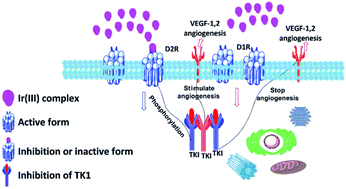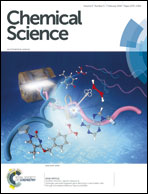Cell imaging of dopamine receptor using agonist labeling iridium(iii) complex†
Abstract
Dopamine receptor expression is correlated with certain types of cancers, including lung, breast and colon cancers. In this study, we report luminescent iridium(III) complexes (11–14) as intracellular dopamine receptor (D1R/D2R) cell imaging agents. Complexes 11 and 13, which are conjugated with a dopamine receptor agonist, showed superior cell imaging characteristics, high stability and low cytotoxicity (>100 μM) in A549 lung cancer cells. siRNA knockdown and dopamine competitive assays indicated that complexes 11 and 13 could selectively bind to dopamine receptors (D1R/D2R) in A549 cells. Fluorescence lifetime microscopy demonstrated that complex 13 has a longer luminescence lifetime at the wavelength of 560–650 nm than DAPI and other chromophores in biological fluids. The long luminescence lifetime of complex 13 not only provides an opportunity for efficient dopamine receptor tracking in biological media, but also enables the temporal separation of the probe signal from the intense background signal by fluorescence lifetime microscopy for efficient analysis. Complex 13 also shows high photostability, which could allow it to be employed for long-term cellular imaging. Furthermore, complex 13 could selectively track the internalization process of dopamine receptors (D1R/D2R) in living cells. To the best of our knowledge, complex 13 is the first metal-based compound that has been used to monitor intracellular dopamine receptors in living cells.

- This article is part of the themed collections: Most popular 2018-2019 analytical chemistry articles and In celebration of Chinese New Year


 Please wait while we load your content...
Please wait while we load your content...